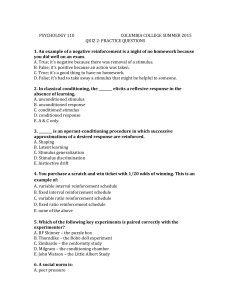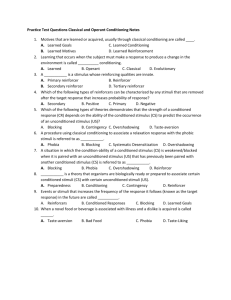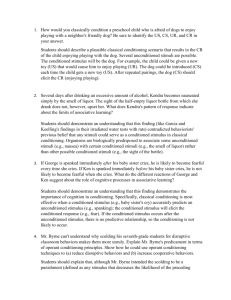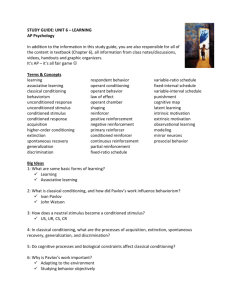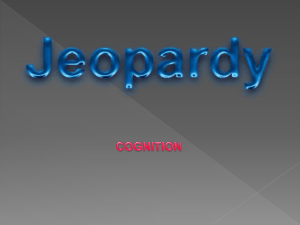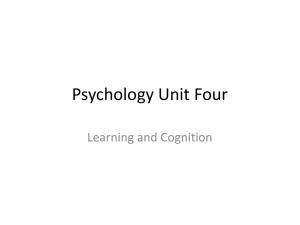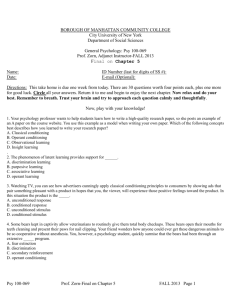Learning Practice Test Key
advertisement
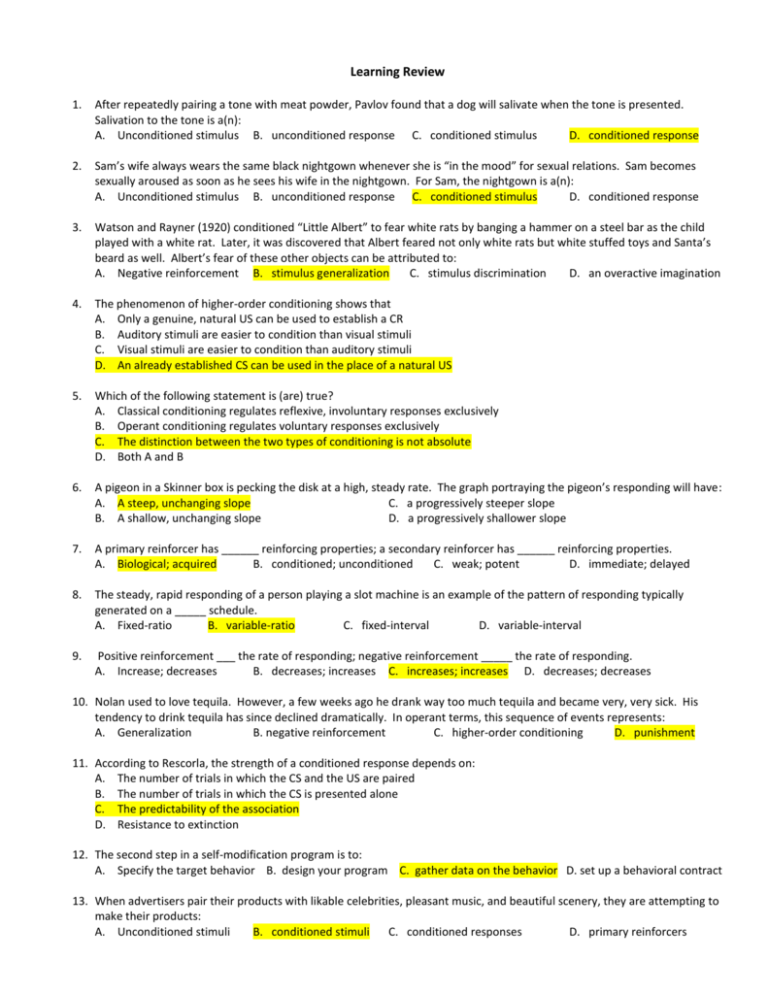
Learning Review 1. After repeatedly pairing a tone with meat powder, Pavlov found that a dog will salivate when the tone is presented. Salivation to the tone is a(n): A. Unconditioned stimulus B. unconditioned response C. conditioned stimulus D. conditioned response 2. Sam’s wife always wears the same black nightgown whenever she is “in the mood” for sexual relations. Sam becomes sexually aroused as soon as he sees his wife in the nightgown. For Sam, the nightgown is a(n): A. Unconditioned stimulus B. unconditioned response C. conditioned stimulus D. conditioned response 3. Watson and Rayner (1920) conditioned “Little Albert” to fear white rats by banging a hammer on a steel bar as the child played with a white rat. Later, it was discovered that Albert feared not only white rats but white stuffed toys and Santa’s beard as well. Albert’s fear of these other objects can be attributed to: A. Negative reinforcement B. stimulus generalization C. stimulus discrimination D. an overactive imagination 4. The phenomenon of higher-order conditioning shows that A. Only a genuine, natural US can be used to establish a CR B. Auditory stimuli are easier to condition than visual stimuli C. Visual stimuli are easier to condition than auditory stimuli D. An already established CS can be used in the place of a natural US 5. Which of the following statement is (are) true? A. Classical conditioning regulates reflexive, involuntary responses exclusively B. Operant conditioning regulates voluntary responses exclusively C. The distinction between the two types of conditioning is not absolute D. Both A and B 6. A pigeon in a Skinner box is pecking the disk at a high, steady rate. The graph portraying the pigeon’s responding will have: A. A steep, unchanging slope C. a progressively steeper slope B. A shallow, unchanging slope D. a progressively shallower slope 7. A primary reinforcer has ______ reinforcing properties; a secondary reinforcer has ______ reinforcing properties. A. Biological; acquired B. conditioned; unconditioned C. weak; potent D. immediate; delayed 8. The steady, rapid responding of a person playing a slot machine is an example of the pattern of responding typically generated on a _____ schedule. A. Fixed-ratio B. variable-ratio C. fixed-interval D. variable-interval 9. Positive reinforcement ___ the rate of responding; negative reinforcement _____ the rate of responding. A. Increase; decreases B. decreases; increases C. increases; increases D. decreases; decreases 10. Nolan used to love tequila. However, a few weeks ago he drank way too much tequila and became very, very sick. His tendency to drink tequila has since declined dramatically. In operant terms, this sequence of events represents: A. Generalization B. negative reinforcement C. higher-order conditioning D. punishment 11. According to Rescorla, the strength of a conditioned response depends on: A. The number of trials in which the CS and the US are paired B. The number of trials in which the CS is presented alone C. The predictability of the association D. Resistance to extinction 12. The second step in a self-modification program is to: A. Specify the target behavior B. design your program C. gather data on the behavior D. set up a behavioral contract 13. When advertisers pair their products with likable celebrities, pleasant music, and beautiful scenery, they are attempting to make their products: A. Unconditioned stimuli B. conditioned stimuli C. conditioned responses D. primary reinforcers 14. John knows that food is a primary reinforcer because it A. Is associated with learning B. Satisfies a biological need C. Is based on classical conditioning D. is based on operant conditioning E. is subject to the law of effect 15. Tyler’s psychology class was classically conditioned to salivate to a tone that was paired with lemonade powder. Over the following two weeks, Tyler’s teacher would continue to sound the tone, but nobody in the class consumed any more lemonade powder. After several days of this, students stopped salivating to the tone. This demonstrates: A. Spontaneous recovery B. reconditioning C. extinction D. higher-order conditioning E. superstition 16. Extinction does not necessarily indicate that learning has been lost. Evidence for this can be seen in A. Spontaneous recovery B. stimulus discrimination C. the rate of reconditioning D. stimulus generalization 17. Sarah used to love orange juice. However, after she drank a large glass one morning, she became violently ill. Now Sarah refuses to drink the juice. Even the thought of it makes her queasy. This is most illustrative of A. Stimulus discrimination B. stimulus generalization C. taste aversion D. spontaneous recovery E. extinction 18. Jeb’s dog trainer explains that Jeb’s dog will be more likely to engage in behaviors following by a reinforcement and less likely to engage in those followed by a punishment. Jeb’s dog trainer is alluding to A. Superstition B. higher-order conditioning C. the CS D. negative reinforcement E. operant conditioning 19. Pat hits his sister Kayla with his toy. His mother takes the toy away. Pat stops hitting his sister. This is an example of A. Classical conditioning B. negative reinforcement C. punishment D. secondary reinforcement 20. John B. Watson, Thorndike, and B.F. Skinner embraced which of the following approaches to psychology? A. Cognitive psychology B. humanism C. behaviorism D. biological psychology E. psychodynamic psychology 21. On her seven block walk to school each day, Danielle passed several side streets. When Danielle’s mother told her they were going to visit a friend on Park Drive, Danielle knew immediately which street to turn on. This is an example of A. Predictive value B. vicarious experience C. insight D. latent learning E. operant conditioning 22. Samuel watched his sister have her mouth washed out with soap for swearing. As a result, Samuel has refrained from swearing. This demonstrates the concept of A. Classical conditioning B. modeling C. observational learning D. punishment E. negative reinforcement
